#chicken cassoulet
Explore tagged Tumblr posts
Photo

Hearty French Chicken and Sausage Cassoulet
0 notes
Note
as a non american i have to ask what american cultural food is there.. i cant think of anything
there is creole cuisine of the usamerican south that is a blend of indigenous, west african, french, and spanish food (side note creole cuisine is not a monolith, there is creole food basically everywhere that was colonized & had a large population of enslaved people)
there is also cajun, which is specifically from the southern state louisiana, it has a lot of similarities to creole cuisine as it is influenced by the acadian french, west african people, and the spanish (ppl often use creole and cajun terms interchangeably but they are distinct)
the food of hawai'i which started as indigenous food of the islands and the goods that was traded within the polynisian triangle, but because of colonization has influences from the US military (spam being a notable case of this), portugal, japan, and china
there is south western cuisine (and the many subtypes) that blends indigenous (pueblo, O'odham, and more) colonial spanish, and mormon foods! this food was shaped by the jobs the people of this area held - lots of influence from cowboys/vaqueros and ranch workers. each southern state has a specific twist!
soul food is based on what enslaved people cooked for themselves, actually a lot of cultural knowledge was passed down & preserved in soul food! lots of southern dishes are based on, inspired by, or straight up stolen from soul cuisine. during the 60s soul food restaurants were important places for organizing! there are also several different styles of bbq
midwestern cuisine is based on various european foods (mainly eastern europen but not solely) and also the agriculture of the area (lots of wheat & pork).
since ~1850 there has been chinese american cuisine! fortune cookies, crab rangoon, general tsos chicken and beef & broccoli are all chinese american.
italian american food uses more cheese & milk than italian food. there are also differences in how we serve pizza
the hot dog is a classic american food! in germany frankfurters weren't served on buns. again most major cities of the us have their own style of hot dog.
other american foods are cheese stake, clam chowder, many fruit pies, milkshakes and rootbeer are all usamerican
potatoes, corn, squash, tomatoes, maple syrup, cashew, pecan, peanut, sweet potato, avacado, chocolate, allspice, chili peppers, lima beans, and vanilla are all foods that are from the americas and are NOT native to europe.
no vodka, no goulash, no christmas turkey roast, no cassoulet, no gazpacho, no cashew korma, no shakshouka, no bruschetta, no gnocchi, no aloo gobi, no colcannon, no latkes, no polenta...
222 notes
·
View notes
Text
Butcher!Simon this, Butcher!Simon that...
How about FISHERMAN!Simon, who slams a cleaver down between the head and the body of a whole tuna in one fell swoop, without much fuss, sliding the head into a bucket of other, similar, severed tuna fish heads, then carefully butterflies the tuna between its two planes of flesh, with as much care as a chef might spatchcock a chicken for cassoulet, gliding his gloved fingers down the middle to part either fillet, deftly shaving away the bones in yet one more fell swoop - for one doesn't become a fisherman without first mastering how to prepare a catch, as the Captain of the boat tells him every Monday and Thursday and occasionally Saturday - before weighing, bagging and aptly pricing either cut, as well as tossing the bucket of heads out into the alleyway for the pier dogs to chew on whilst they're out sailing rough seas.

| Masterlist |
#this has probably been done before#i do have more thoughts if people might want that#simon ghost riley#ghost cod#cod ghost#call of duty ghost#call of duty#simon riley#ghost mw2#call of duty fanfic#callofduty#cod#call of duty fanfiction#simon ghost riley headcanon#simon ghost riley au#call of duty fandom
46 notes
·
View notes
Text
Rating Frenchie’s Food Refs in The Boys

Roast chicken with green beans and potatoes
While he holds Kimiko prisoner in what looks like an abandoned squat, Frenchie takes great pleasure in describing the dinner he has prepared for her. He presents her with a pan-roasted chicken, seasoned simply with olive oil, fresh herbs, and salt and pepper. It is served alongside green beans and roasted potatoes.
I love that Kimiko is literally chained to a radiator and Frenchie is treating it like a first date.
Also, I thought it was cute that he gave Kimiko plastic cutlery to be on the safe side. As if he hadn’t just watched her murder a bunch of dudes with her bare hands!
🇫🇷🇫🇷🇫🇷🇫🇷 🇫🇷 /5
——
Madeleines

After she stops trying to kill him, Frenchie teaches Kimiko how to make Madeleines, buttery little cakes shaped like seashells.
Adorable. I love how quickly he flips from “I can’t trust you with metal utensils because you will murder me.” to this cozy scene.
I’ve heard that madeleines are the kind of sweet treat that French children are given after school for their goûter (basically, an afternoon snack). If that’s a nostalgic memory for Frenchie, it makes it even sweeter that he chose to bake these with Kimiko.
Also, madeleine pans are pretty much only good for one thing—making madeleines. So my question is…why does Frenchie have multiple pans stashed in the safe house?
🇫🇷🇫🇷🇫🇷🇫🇷🇫🇷 / 5
——
Jambon Beurre and Diet Coke

After Butcher is reunited with Becca and introduces her to The Boys, Frenchie makes a jambon beurre for her. It’s a classic French sandwich—typically just good butter and ham on a crusty baguette. As he explains, it’s deceptively simple but the end result is so much greater than the sum of its parts.
The bow is so silly. It’s not load bearing at all and serves no function but to look cute for Becca. I think it’s kind of sweet. They even remember her favorite drink—Diet Coke.
It makes me wonder how often this came up. Did Butcher talk often about how much his late wife loved Diet Coke? Or had he mentioned it once and his friends squirreled away that tidbit?
Frenchie gets points for the thoughtful gesture. But with a sandwich with so few ingredients, every element needs to be perfect. I’m docking points because I’m not confident he has access to decent fresh baguettes in this dank basement in Queens.
🇫🇷🇫🇷🇫🇷/5
——
Donut Hamburger

At Voughtland, Frenchie is appalled at this godless American delicacy.
However, later that day, he puts his disgust aside and volunteers to take Kimiko to eat as many donut hamburgers as her heart desires because he just wants her to be happy. Awww.
🇫🇷🇫🇷/5
——
Sad Salad

Sad boring Colin texts his sad boring salad to Frenchie.
Colin was hot but he and Frenchie were doomed from the start. For the obvious reasons, of course, but also because the writers forgot to give him a personality.
What a boring thing to text? Also, it looks like Colin googled “salad” and sent Frenchie some stock art?
0/5
——
Cassoulet

Little Nina claims that Frenchie’s cassoulet is so good it made her come.
Probably a bit of hyperbole because cassoulet, while it is delicious, is also heavy AF. It typically has duck confit (duck slow-cooked in its own fat), pork sausage, more pork, and creamy white beans.
Up until this point, cooking for Frenchie was always an act of love. He associated it with good memories of his mother. It was one of the ways he showed he cared. And it’s telling that Little Nina would use something pure and twist it into something ugly. The whole point of her graphic comment is to shock and assert dominance.
🇫🇷🇫🇷/5
——
Office Donut

Frenchie makes a mess eating a donut at the office.
After getting admonished by MM for not using a plate, Frenchie replies, “But I never use a plate when I eat your mother’s sweet and savory vagin.”
What a wild, completely nonsensical response. I love how quickly that escalated. Also, I think this is the first time we’ve seen Frenchie consume anything that was not drugs or alcohol. I’m with MM, though. Use a plate!
🇫🇷🇫🇷🇫🇷/5
#This is what happens when you make people wait 2 years between seasons#frenchie the boys#frenchie x kimiko#tomer capone#the frenchman#kimchie#frenchie and kimiko#kimiko x frenchie#the boys tv#the boys#kimiko miyashiro#billy butcher#becca butcher
22 notes
·
View notes
Text
Marauders era characters and their favorite foods
Lily Evans: She LOVES strawberry’s. She will have anything strawberry flavored and that what she says.
Marlene Mckinnon: Marlene would love steak. Just well seasoned steak and she’d be perfectly fine.
Mary Macdonald: thin mints. i will not elaborate.
Sirius Black: Cassoulet. He was so used to eating fancy foods and Effie made this for him when he ran away.
Remus Lupin: anything chocolate. if it contains chocolate he’ll eat it right up munch much chomp chomp
James Potter: He starts crying when people ask him to choose between Chicken Korma and salmon.
Peter pettigrew: he LOVESSSS salads. He loves literally any kind of salad.
Dorcas Meadowes: She really likes grapes but her favorite dish is Tacos.
Pandora Rosier/Lovegood: she found out about fairy bread and tried it, had a mental breakdown over how good it was and now eats it for breakfast every day. and cinnamon rolls.
Regulus Black: he absolutely adores mac and cheese with hot dogs and that’s that
Barty Crouch Jr.: THIS MAN LIVE LAUGH LOVES GARLIC BREAD HE JUST LOVES IT
Evan Rosier: if you give him some well seasoned chicken wings he’ll be happy
#james potter#sirius black#remus lupin#jegulus#sirius x lupin#wolfstar#regulus and evan and barty#sirius#sirius and regulus#remus and regulus#maruaders era#the marauders era#dead wizards from the 70s#dead gay wizards from the 70s
102 notes
·
View notes
Text

Leftover goose cassoulet with flageolet beans, sliced garlic bratwurst, and slab bacon. This year I followed the @seriouseats suggestion and boosted the chicken stock with gelatin. It did make a nice crust (albeit a little on the dry side and I did need to add more water before serving, there’s an adjustment process). #dinner #cooking #cassoulet #goose
3 notes
·
View notes
Text

FFXIVWrite 2024 - Day 15: Free Day
LA BATARDE
ENTREE
Soupe au Pistou Pistou Soup
Soupe à l'Oignon Onion Soup
Gougères Sauteed Pastry With Cheese
Lentilles Du Puy Mijotées Simmered Du Puy Lentils
MAINS
Cassoulet de haricots, saucisse fumée et poulet Cassoulet of Beans, Smoked Sausage, and Chicken
Ratatouille de légumes d'été Ratatouille of Summer Vegetables
Coq Au Vin Stewed Poultry In Wine
Fricassée de poulet au pain grillé Chicken Fricasee With Toasted Bread
DESSERT
Fromages d'Eorzea Cheeses Of Eorzea
Crêpes aux baies de Gridania et sirop Crèpes with Gridanian Berries and Syrup
Tarte aux pommes avec glace Apple Tart With Iced Cream
5 notes
·
View notes
Text
It's official... Chitarch has some domestic fluff and quality time as a love language.
I'm going a bit out of order here with this one... It's supposed to be post-Mockingjay when Chiasa and Plutarch are in a more established and public relationship. I needed a bit of fluff this month and I'm sure many others do too... Enjoy!
(I know a pinned masterlist is probably needed at this point and I'll pin it soon...)
As always, tagging @plutarchheavensbee
A cool, rainy winter day always tended to set the backdrop for a slow afternoon, and such a leisurely time on a weekend had Chiasa rifling through an unpacked box. It had been a few weeks since she'd moved in with Plutarch, but they’d both been so busy, a lot of housekeeping was either neglected or outsourced. Keeping her fashion house afloat and guiding her nephew and his girl Minerva (Yes, Minerva… She was still amazed how the young woman was able to fool her) through the early days of parenthood was hard work. Plutarch's television and democratic guidance filled his schedule as well, and while they found time for each other, be they apparences at his side, his growing attachment to Marcus, and even just evenings… Real days off ought to have ration coupons of their own.
At least now, Chiasa had time to sift through some of her parents’ old things. Even though the new staff was wonderful, it wasn't easy for her to trust practical strangers with such memories. She’d examined a pair of old gloves that belonged to her mother; a bit of wear and tear, but fixable. Tigris did make them, after all. A couple of old polaroids made an appearance as well… The four of them; her mother, father, herself, and her sister before the world got the best of them… Her mother, father, and Tigris at her very first show, how the three always smiled… Herself and Quinta on their first day at the Academy. Eww… The uniforms were absolutely hideous back in the day and she remembered cutting hers up the day she graduated. At least they had the sense to update 20 years ago, so Marcus was never caught in that outmoded monstrosity.
There was one thing that caught her eye, though… An old blue binder filled with lightly aged paper. She took it out and opened it to a recipe written in her father's neat handwriting. So that's where she left this… Back at her old place, she’d kept these in the kitchen, but she must have been feeling nostalgic and sorted it accordingly. She couldn't help but smile as she recalled her father in the kitchen, humming or scat singing as a rock n’ roll or jazz record played and he whipped up another spicy smelling culinary masterpiece. He adored cooking, the way it brought so many people together and was one of the few ways he stayed in touch with his roots. What a time to remember, to be alive then… Hmm…
The chicken cassoulet in the front, while delicious, wouldn't do with the rationing about. Perhaps a yaki dish? Of course! Kare was simple enough, delicious, and she still had some good roux.
Now to recruit some help…
It wasn't surprising to find Plutarch in his library, hunched over an old book with a notebook on the side. Maybe Chiasa should have scolded him for working on a day off, but he looked so damned cute in his reading glasses… Still, she couldn't lean on that doorframe forever, lest she forget her mission. Quietly, she snuck behind his chair and reached over to gently rub his shoulders. Glancing at the familiar pink on her nails, he relaxed and leaned into her touch.
“Dear… Now this is worth getting used to,” he murmured.
She moved beside him and leaned down for a soft kiss.
“This place was always so very you… But this room? If it were any closer, there would be a cozy little fire in that fireplace,” Chiasa remarked, “What would it be… The warmth of your embrace? Your burning passion to light the world?”
“I see you’ve been looking into that poetry I’ve suggested,” he quipped, “But that's not a bad idea… It should be fixed in a few days and I’ve been meaning to replace that rug…”
What an idea, the two of them curled up together on a beautiful night, and maybe eventually lost in each other… Although… was he trying to distract her from his desk work? His chicken scratches and shorthand could be tough to read at times, but the wizened book was clear enough; Chiasa spotted the name “John Locke” on the spine, one of the thinkers he loved talking about.
“As much as I love your dedication, what have we said about all work and no play?” she asked.
“That it makes me a dull boy and you a dull girl… Not to mention our first foundation,” Plutarch replied, squeezing her hand, “But you know… Locke believed that we're not born knowing, but that we have to learn through life and study, like I am now.”
“I can't argue with him there… The world definitely has its ways of delivering life lessons, both beautiful and harsh,” she agreed, “But… Does he say anything about working oneself to death or eating between lessons?”
He thought for a moment. “I think being fed would fall under the “life” part of his life, liberty, and property… As for work, that's a good question to consider, especially with the labor unions popping up in the Districts–”
“Plutarch…”
When he opened his mouth to protest, a growl from his stomach betrayed him.
“I suppose I could take a little break…” he relented, “Perhaps if you join me back here afterwards.”
Not a bad plan… So long as they got to just be human for a while. Chiasa led him to the kitchen and opened the binder on the counter to the curry recipe.
“You know, I’ve told you how I grew up, how food was important to my family… With is settled in and some time on our hands… I love you, and I’d like to bring you into the fold too,” she said.
“I love you too… And I’m honored,” Plutarch replied before studying the recipe, “I think I’m familiar… Marcus really likes this, doesn't he?”
“Oh, his favorite is not for the faint of heart… He likes a ghost pepper roux. I have one on hand that's closer to my dad's original.”
Her darling nephew always had extreme taste buds… Always going for the sour candies and spiciest meals. It could have been worse, he could have liked everything plain. Her father would be turning over in his grave if such a thing happened in their own family.
Chiasa started to gather the ingredients while Plutarch gathered the equipment and utensils. Once the pair donned some aprons, she noticed him looking excited, yet still a bit apprehensive.
“I have to warn you, I'm still a little new at this,” he said.
“I don't think there's much to worry about, I’ve seen you bake bread before,” she replied with a reassuring smile, “And you’ve done it well.”
“True, but that’s baking. Baking is more precise. Cooking, however… There's a lot of experimentation, trial and error… And you eat it rather than look at it or wear it or program it.”
“Cooking is an art for a reason… Some of these are family recipes, but a lot of them came out my my dad's experimenting… But was I ever the willing lab rat,” she recalled, “But hopefully a recipe will have you more comfortable… Why don't you start by slicing the onions while I take care of the meat.”
Chiasa started cutting some chicken into strips and glanced over to see how her partner was doing. Keeping his glasses nearby was smart; an age old trick to stave off the tears. Luckily, he seemed to be a natural. He managed the potatoes with minimal guidance too while she took care of the more complicated carrots. Once she lightly seasoned the meat, she was happy to see everything else ready.
“Great job!” she praised, “I’ll make a sous chef of you yet, Ploot… Now, before we stew, all this needs to be sautéd. I can take care of that, but I’d like you to pay close attention.”
As she turned on the stove, he stepped towards her and cheekily put an arm around her waist.
“Close enough for you?” he teased.
“It's a start…”
Once it was warm enough, Chiasa tossed the onion wedges into the pot and they landed with a satisfying hiss. She gave Plutarch a kiss on the cheek before grabbing a pair of cooking chopsticks to stir. Her father liked to say everything tasted better with them, after all.
“Only stir them occasionally… You want them translucent and a nice brown color,” she instructed.
She felt his head rest against hers, and she couldn't help but blush and chuckle to herself. As she finished, she held herself back from pouting at the thought of him letting go, but he had to learn…
“Honey, why don't you add the garlic and ginger, and I’ll tell you when to add the chicken,” she requested.
Thankfully, he seemed to feel the same, but managed to play off his own disappointment as playful. Once he added the aromatics, she was quick to stir it in, making sure none of the onions missed out on the extra flavor. As the chicken was added, Plutarch took a whiff of the strong aroma and grinned.
“Mmm, that's starting to smell incredible…”
“And we're not even finished yet,” she gushed, “Do remember when we add the broth, it barely covers everything so far.”
The remaining ingredients had to simmer for a few minutes, and even Chiasa had to admit she was getting hungry too. Even so, she was still grateful to finally have time to share this with Plutarch. He really knew how to run himself ragged, but admittedly, she wasn't much better, even before they got together.
“Looks like it's already turning out great… I’ve heard tales of your father's cooking, I’m excited to try something of his,” he said as he gently pulled her close.
“If only you could have tried it in person… I know I try, but I could never live up to it. I guess he had this natural kind of talent,” said Chiasa, “It really is a shame you never met…”
“From what Tigris told me, he was a lot like you… Tender-hearted, passionate, a quiet sort of strength in adversity…” he mused, “I’d like to think we’d get along just fine.”
Chiasa cupped his face and rested her forehead against his. “And I'm sure he’d love you once he knew you… Maybe he might be a little bit shocked at us, but we both know he wasn't much better.”
The couple dissolved into laughter at such a thought… After all, Tigris was still fairly young when she and him started seeing each other. Technically, Plutarch was much older than the catlike stylist was back in the day when he and Chiasa started things up.
Unfortunately, their embrace was interrupted by the ding of the timer. Oh well… All would start again soon. She cleaned out the foam, got out a wooden skewer, and turned to him.
“Pop quiz… How can you tell that it's all cooked?” she asked.
“Hmm… Good question. I’d probably say it's a certain look or smell, but I suppose it has some to do with the skewer in your hand,” he replied.
“Right. If you can stick this all the way through a dense veggie, it's time to add the roux. Wanna try?” she asked.
“I don't see why not.”
He took the skewer from her and carefully stuck it into a potato on top of the mixture. It indeed went all the way through.
“Wonderful,” she praised, taking out a jar filled with brown cubes, “Now for the roux… These were made from scratch a while ago, my dad's traditional way… Cayenne, tumeric, nutmeg, black pepper, thyme… dash of citrus and chili. It's a medium kind of spice, but that was low for him.”
“I can handle it,” he reassured her, “I imagine he hated state dinners and galas…”
“Oh yes… If any of his committees were throwing something, he did his best to get ahead of the catering,” she replied, “If not… He always had a little vial of paprika in his pocket.”
“He would have hated the family dinners I had growing up.”
“From what you’ve told me… It's hard to imagine anyone would.”
Chiasa turned to give Plutarch a brief hug as he stiffened at the memory, then slowly nodded. His stories of his younger years seemed so stiff, orderly, and cold as patrician families could be at times. She recalled him not knowing how to react when she showed him genuine tenderness; hell, even when she started flirting with him, he wondered if she had some ulterior motive.
Even when he couldn't hold his emotions back one night, he was cautious and confused at what she believed was common sense in comforting a loved one. Once she held him, however, he'd melted. He let his tears out on her shoulder and held on tightly, as if he was afraid she’d disappear. She'd realized the poor man was so deprived of unconditional love and any sense of security that she'd nearly teared up herself. Right now, hopefully along with the brave new world, he could start to move on from an isolating past.
Chiasa let go and gently stroked his cheek. “You don't have to go back… I’m here for you. This meal always felt like a warm hug to me too.”
Plutarch shut his eyes and smiled. “Thank you… I suppose by now you know how incredible it feels to hear such a thing… And actually believe it.”
She invited him to dissolve the roux as she held a ladle of broth to speed the process along. The concoction smelled so wonderful as it finally came together; maybe a little strong for some, but comforting for the right people.
“Now, traditionally, this is served with rice, but we don't have any,” Chiasa lamented, “I checked.”
“With all the talk of trial and error, surely we can find something else.”
Plutarch eyed a nearby breadbox and opened it, revealing half a loaf.
“Well… Most stew-like meals are served with bread for dipping, aren't they?” he added.
“Yes, you're right! And homemade too… Perfect!” she gushed, “Really, I’m surprised there's still some left… Yours is just delicious.”
“Hmm… I suppose we have been a little preoccupied this week,” he relented, “I'll slice some for us, you grab some bowls.”
A most unusual suggestion of eating in the library followed. Chiasa was almost skeptical until she saw Plutarch set the old book and notebook safely aside as she set her bowl on one side of the desk. Before she even asked, he was quick to pull up a chair for her to sit in across from him. As they sat, she watched him sniff at his bowl curiously before dipping his bread in for a bite.
“Hmm… Mmm!” he praised, “This is really something… A little bite, but not terribly spicy… Some umami to be expected… Oh! Didn't expect the sweetness. I don't remember adding anything sweet…”
She chuckled a bit at her lover analyzing such a homey dish like a food critic. What an adorable quirk…
“That's in the roux,” she explained, “It's normal to have some secret ingredients with curry, and I’ve told you about the cayenne and black pepper, thyme, nutmeg… But also a bit of honey and cinnamon. Do you taste it, honey?”
They both took another bite at the same time, and Chiasa couldn't help but smile at their results. It certainly wasn't bad for a non-cook, and she couldn't help but warm up inside… And she finally could understand why, the very same reason she looked forward to Tigris’s visits when she was a girl.
Plutarch was a bit more thoughtful in his bite, almost as if he was switching from fine dining to viticulture with his slow, pensive chews.
“Yes… That's it. It's all coming together now,” he replied, “And what about you, dear? I know you're used to it, but surely having it again still brings back some memories.”
“Oh it does… Dare I say, even better, like my whole self has been lifted up.”
“Hmm?”
“Well… I guess there is a reason for it,” said Chiasa, “Of course, food wasn't just a way of keeping my dad's cultures going, but a way of bringing people together. Serving is one thing, but preparing them with someone is different… Sometimes you can taste that bond, and it's all the better.”
“Ah… You're saying it's better because we made it together,” he replied.
“There is that sense of accomplishment, but I got it whenever I helped out, but it wasn't quite the same,” she said, “This… I hadn't had anything like it in many years. Actually, I don't think I’ve experienced it myself. It's a little hard to explain to someone who isn't used to this, but… I guess you could say we added another secret ingredient.”
Plutarch smiled and took her hand across the desk.
“And here I thought ‘made with love’ was another corny saying… But I suppose you’ve been proving most of them right for a while now,” he replied tenderly, “I should have spotted it from the beginning. You were so happy, so excited to share this dish and get me involved. I was a little out of my element, but your ease, your enthusiasm… Just the way you smile and light up when you're in yours… It soothed me immediately.”
It was lucky the couple were fond of those bowls, otherwise Chiasa would have lept over that desk immediately just to get close.
“Oh, Plutarch… That's beautiful.”
“It’s exactly what I think… I love you.”
“I love you too…”
It wasn't long before both were finished and the leftovers and dishes were stowed away. As promised, however, they’d soon returned and Plutarch was in his big chair once again. When Chiasa tried to take her original seat, he shook his head.
“This might get a bit complicated, you should get a little closer to read it with me,” he said.
“Oh? How close?”
He patted his lap with a sly grin and she smirked and sat. Almost immediately, he wrapped his arms around her and pulled her into a deep kiss. That sly bastard… but one of the best traps to fall into.
“You're so damned devious, Ploot,” she murmured against his lips.
“You know I try, Chiasa.”
She pouted when they had to pull away, but the spark in his blue eyes as he opened the book back to its marked passage. As much as she worried about him working himself to death, his dreams for the future always had him hopeful, animated, and so handsome in the light…
They really should invest in that new, softer rug for the fireplace if they were going to spend their off-days trading passions like this. And it was shaping up to be a wonderful way to spend their quality time.
“Darling, go on… What is it that Mr. Locke says that you love so much?” Chiasa asked.
“I said before that knowledge isn't innate, but the rights of life, liberty, and property are, and any government who denies them deserves to be overthrown.”
“But of course… You’ve managed that already. And what's this letter the book is talking about?”
“A Letter Concerning Toleration… It's been a while since I’ve read through it… I remember it being a little dated for our time, but maybe we can apply culture as well as religion to it… Let's go over it together.”
#thg fanverse#oc: chiasa lapin#chitarch#plutarch heavensbee#oc x canon#plutarch x oc#hunger games fanfiction#domestic fluff#Extra credit for catching the NIV references#These two need downtime#The trope where one character gets really into something and lights up and their partner is just like 😍🥰#I love it okay
2 notes
·
View notes
Text
Come the warm, ripening days of summer and I imagine that I am closer to a more ancient, basic and healthful style of vegetable and grain eating than in my cold and meaty winters. I am seduced by my garden and neighboring farm stands vivid with color and flavor.
I avoid a lot of hot time in the kitchen. Much is eaten raw or almost: vegetable soups - gazpacho has many names and many recipes - vegetable sauces for rice or pasty and endless salads. I have corn on the cob and other vegetables in every form: grilled, roasted, steamed, stir-fried, puréed and combined in a variety of stews to be eaten hot, cold and at room temperature. Fresh herbs, garlic, onions and imagination sauce the dishes. The first beans from the pod or dried beans, fruit, cheese, bread and wine complete my menus.
There is almost no meat and little chicken or fish - an occasional grilling, a stew more vegetable than meat, a slice of cold meat or charcuterie, a boiled egg, a little tuna from the can.
I eat this way for pleasure as well as in a modern quest for a more healthful diet. Those came before us ate this way to take advantage of what they had - often limited. While we tend to see a cornucopia-vision of the past, rich in more seasonal, more natural foods, it is only partly true.
Winter in most climates was short of fresh vegetables, and the world relied on salting, pickling, drying and cold storage for any vegetables at all. The animal protein we are fending off today was in short, expensive supply.
With the best will in the world and without an evil intention, food writers and the natural inclination of all of us to glamorize the past and the far away have been guilty of distorting our view of the way the world eats. By selecting the best, the most festive food of other places or times, we have come to see them as halcyon visions of plenty, filled with meat and seafood, sugar and cream.
It is not sugarplum fairies, but roasts and fries, sausages and sautés, stews and cassoulets that frolic in our Rabelaisian dreams. Southern picnics are enriched with baked hams and fried chicken. Clambakes clutter the shores of a mythical New England. In that world of the imagination, native Africans are awash in chicken and ground-nut stew, native Americans feast on venison and buffalo, Greeks expand over countless dishes of succulent lamb, the Chinese are exquisite in damask while dining on unimaginably choice viands.
The English eat hearty roasts, silken salmon, and mountains of oysters. The French of the mind are various, either robust peasants glorying in rich stews or jeweled aristocrats whose famous chefs set forth succulent sauces. Our Italians live in a world of perpetual holidays, their risotti topped with pungent white truffles.
While not totally untrue - these foods did exist in each of these countries and were eaten by the natives at least upon occasion - such visions falsify the totality of real experience and may contribute to the glut of fat and cholesterol in our lives. We equate these festive foods with good living and think that ,if we can, we should eat this way all the time.
Our ancestors and many peoples all over the world today eat very differently from this skewed perception. Carbohydrate, or stodge, was what really fed and filled up most people. With bread as the staff of life in Europe, scarcity led to bread riots for centuries. Even in the recent past, when the government-fixed price of bread was raised in France, the announcement was carefully scheduled for August when almost all Frenchmen are on vacation.
Certainly, the staple food of the vast majority of the world is still rice, followed by bread and potatoes along with noodles - pasta among them - soy foods, yams, taro, yucca, corn, beans, pulses such as lentils, myriad grains and other starchy foods with names foreign to me. In the past and in much of the present, animal protein, when available, has been primarily a flavoring.
Beasts were not killed promiscuously. They were the cash crops and the providers of the milk and eggs. If a pig was slaughtered in the fall, that was a major event, and a family would hoard the preserved hams for Christmas and Easter, or sliver small amounts for a taste at many meals. A prosciutto bone or other ham bone was an asset to be used and reused in soups until flavorless. Fresh meats were rare; only the overage animal or the single, religiously festive springling was sacrificed.
To envisage a chicken in every pot was to dream of luxury indeed - the most luxurious of Sunday dinners.
if other meats were salted and smoked like bacon, or pickled like corned beef, air-dried like grisson or jerky, or preserved in fat like confit, it was to keep them over the winter and dispense them parsimoniously as special treats.
So when we read recipes for peasant dishes crammed with meat, we should remember we are reading about rare treats, not daily fare. Even fishing nations could have uncertain catches, rough seas and months when it was impossible to put out upon the water. Even plenty might need to be sold. A home-cooked paella was mainly rice, seasonings, oil and vegetables.
The great go-along-withs have been vegetables and fruits, fresh when in season, pickled or preserved for inclement times. A little fat would have come from the possibilities of each region - olive oil, butter and lard. Food was about survival and pleasure when possible. No one got more than nutritionally sound share of meat and fat over the course of a year. It is these daily recipes that are by and large missing or recorded primarily as accompanying dishes in our cookbooks and kitchens.
It is up to us to re-create out of our plenty the sane eating and pleasures that scarcity and invention, herb patch and garden, bestowed on our forebears.
"The Real Past", from The Opinionated Palate: Passions and Peeves on Eating and Food by Barbara Kafka
7 notes
·
View notes
Text
Heirloom Kitchen, Old Bridge NJ
My wife and I enjoyed an absolutely first class dining experience today at Heirloom Kitchen in Old Bridge, NJ.
Food was good, almost shockingly good. I was taken aback at the subtlety of just about every dish we were served. Atmosphere was clean and quirky, somewhere at the intersection of cottagecore, industrial, and kitch. Service was top notch, attentive and professional, from a brigade that couldn't have been much older than my teenage sons.
The menu was a four course prix fixe, including dessert ($89 pp). Tonight's menu featured three or four choices for each course, so we had (difficult!) choices to make. As usual, we ordered extras: a stuffed bread course (which was amazing, both sweet and savory, with onion jam and a whipped feta spread), as well as two a la carte dishes as an additional course, (which the staff sequenced perfectly, despite our last minute addition).
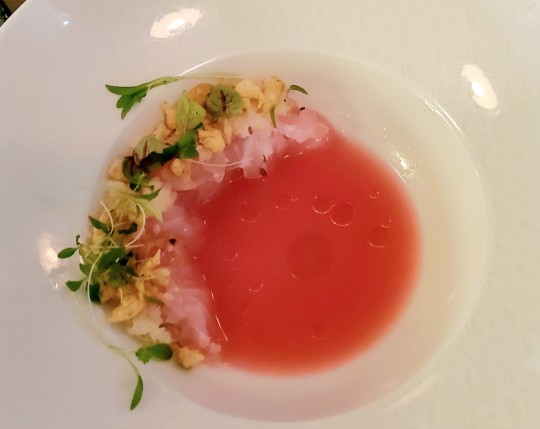
Our first course was a raw cured snapper served in watermelon lime broth and a chicken liver mousse served on brioche. The snapper was served like ceviche, cured in citrus, but served over a vivid red watermelon broth. The flavor of the lime oil popped with the crisp texture of the fish, and rode nicely over the sweetness of the watermelon.
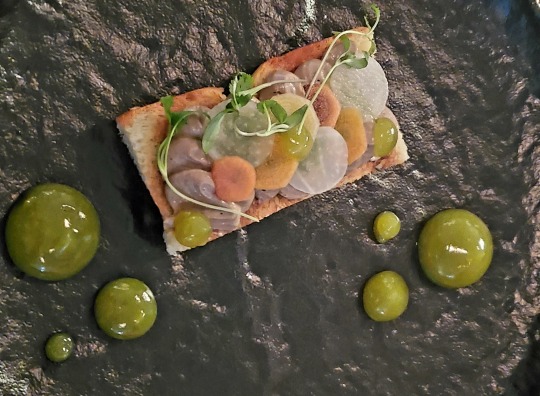
The toasted brioche was topped with a modest shmear of a velvety chicken liver mousse, which would have been a sensational pairing all by itself. But the bite was taken up several notches with the addition of pickled veg, micro cilantro, and emulsified jalapeno on the plate. The acidic and mildly-spicy pop was so helpful to cut the cloying fattiness that normally comes with chicken liver. Very well balanced and clever to keep the spicy element separate on the plate, allowing the diner to dial in their preferred level of heat.
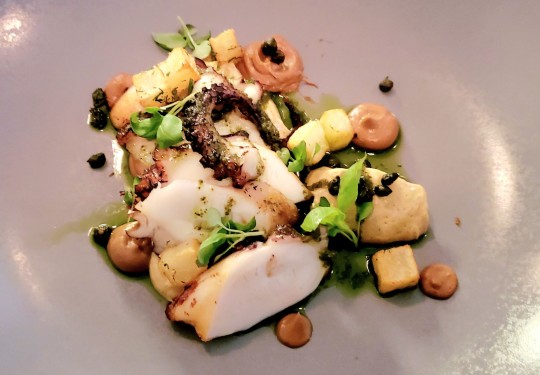
Course number two consisted of grilled octopus and a baked squash. The octopus dish was a master class in the Maillard reaction: just about every item on the plate was cooked to caramelization, but not a single element had that burnt flavor you get when something is left in the pan a few minutes too long. Eggplant, nuts, capers, potato, and even the za'atar - each cooked to its own smoky sweetness then combined perfectly in a harmony like an exquisite campfire.
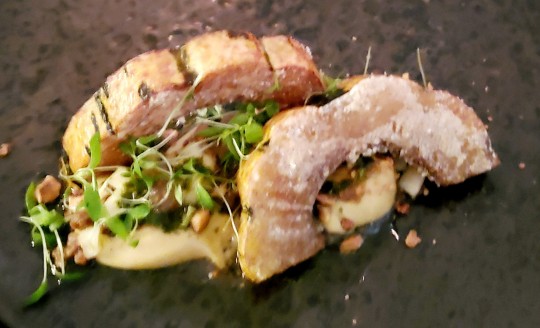
The Delicata squash was served in tender cubes over acorn squash rendered as a mousse and had several different textures across the dish. The apple mostarda complimented the squash in both a expected yet surprising way. That familiar homey flavor of simple baked apples with squash and cinnamon took on a much more sophisticated demeanor in this context.
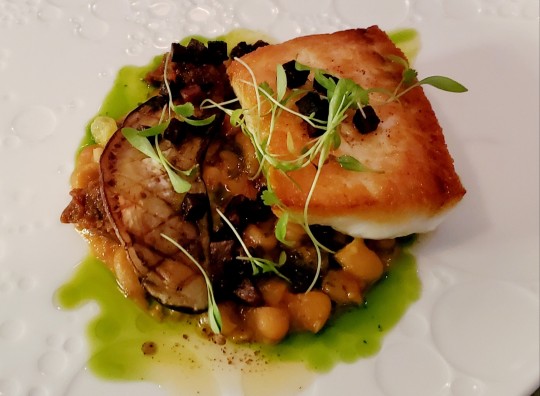
Our third course was a pan-seared fluke and a pork belly deconstructed "tamale". The fish had a great crust and flavor, but could have maybe used one minute less in the pan. But we like our fish under rather than over, so it might have been personal preference. The pepperoni butter was the most surprising element, and one we are going to try to replicate. Each of the other elements - the cassoulet, the sofrito, and the caponata - were executed well enough to stand on their own; in combination, they supported the fluke without overwhelming it.
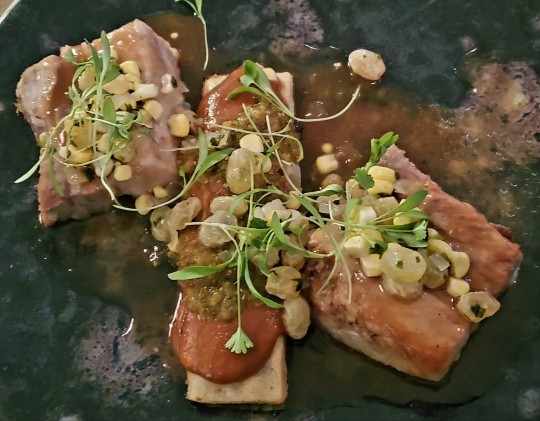
The pork belly was cooked "birria" style, a slow-cooked stew with meat and spices. This dish was clever and incredibly flavorful, with a generous portion of extremely moist and tender pork belly. The corn portion of the deconstructed tamale was served central to the dish, as a simple rectangle covered in the mole sauce. I enjoyed the texture that the corn and wax beans added to the dish, especially given the silky tamale/mole centerpiece. My only wish was that they had gone with a birria "tatemada" style of cooking, where the pork belly was crisped up after being stewed. I missed the sensation of crispy pork fat in my tamale, and I worry that the large moist fat cap on the pork belly might turn off some patrons. But that's just a tiny tweak, not at all a complaint.
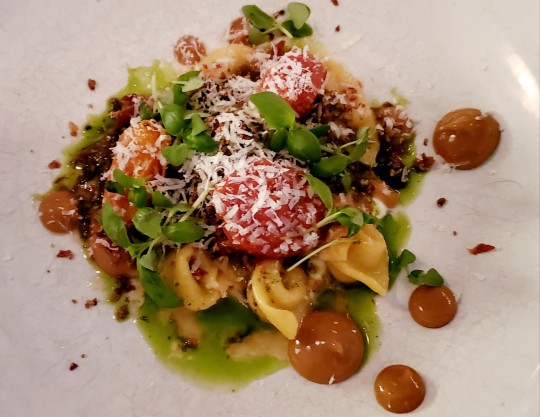
Our bonus course consisted of a pasta dish (Sorpresine), and the duck breast we thought we had to sacrifice in lieu of the pork belly. When our server told us in casual conversation that we could add dishes a la carte, we jumped at the chance to fill in with some of the dishes we had missed. Sorpresine (meaning "little surprises") is sort of an unstuffed version of ravioli. Just folded and cooked, this pasta was served with a sticky-sweet peach agrodolce, tiny tomatoes, and a very moist stracciatella cheese, sister to ricotta. We were so pleased we were able to get this complex yet rustic dish into our menu. It simultaneously felt subtle and lush in my mouth while being reminiscent of Sunday dinners at my grandma's house.
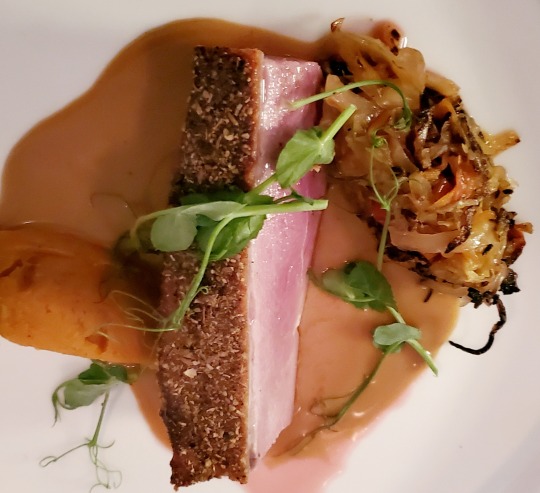
The duck breast was served in a Jamaican style, with a dry jerk rub, a habanero jus sauce, and braised cabbage and squash. The large portion of duck breast was cooked perfectly medium rare, a lovely light warm pink in the center. We cut it into medallions, and smeared each through the spicy jus. While I loved the flavor, I really wanted a more substantial jerk sauce, sticky and clinging to the meat. This dish had such an island inspiration but fell slightly short on the thin jus. The cabbage was tasty but slightly overly-salted to my palate. All of the other flavors were spot on, however, and I wouldn't hesitate to order it again.
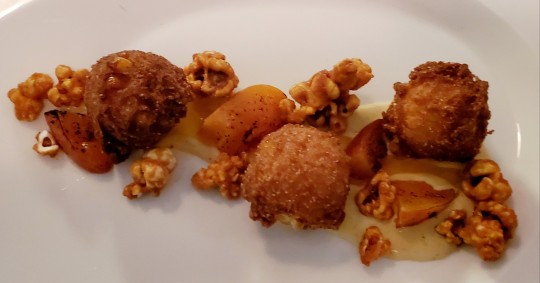
Last course was dessert: we had the hush puppies, and the inspired combination of basil mousse/olive oil cake/Parmesan ice cream. I have to admit I wasn't wild about the hush puppies. Served with caramel popcorn and a smear of creme "elote" anglaise, this clearly chef-inspired dessert fell flat for me. I wanted more fresh in-season fruit, instead of the one lonely bit of peach and gooseberry. I wanted more delicious sauce, instead of the tiny smear. The hush puppies and popcorn were fine but their focus should have been reversed, IMO.
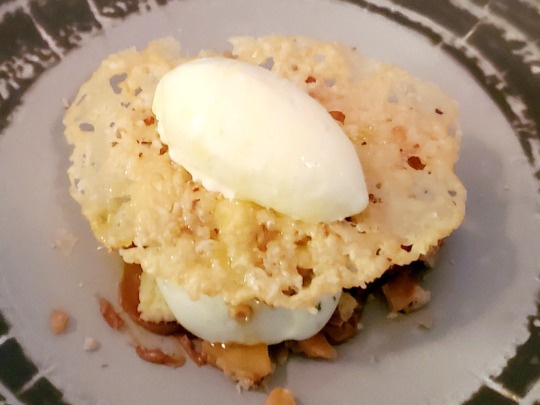
The other dessert was a delightful exercise in contradiction and challenging your preconceptions. Basil mousse, parmesan ice cream, olive oil cake, pine nut brittle - this sounds like the ingredients to a nice savory pesto dish, not a dessert. However, here's a chef's dessert that knocked the ball out of the park on so many levels. The olive oil cake was a moist platform for the ice cream and a tart lemon curd. The pine nut brittle paired as expected with the basil ice cream but the surprise was that it works as a sweet dessert as well as in a savory main. This dish was just over-the-top clever in its conception, almost like it was the response to a dare: "Make a pesto dish, but dessert - go!" However the good balance of sweetness and acid from the lemon and texture from the brittle, all melting together and soaking into the tight crumb of the cake was so startling in its "challenge accepted", perfect execution.
Again, service staff was exquisite, more attentive than many restaurants asking twice the price. Busers were on the move continuously but not obtrusive. Runners knew their food preparation and could answer questions thoughtfully. Our server was funny, engaging, offering her own thoughts and opinions while remaining thoroughly professional throughout
Decor was an interesting mix. Edison bulbs, black fixtures and flatware. Seating that matched but also seemed to come from a yard sale. A library of cookbooks and an open kitchen all contributed to the informal, casual feel. I thought the music was at times a bit too loud for easy conversation though. Our server told us the restaurant started life as a cooking school, and in fact still offers cooking and baking classes, as well as a multi-course tasting experience on Sundays.
Please forgive the extensive review here. I feel like this restaurant is quite possibly one of the best in the state. More than being a "hidden gem", this experience was easily a 5-star fine-dining experience, tucked into a little strip mall off Route 9 in Old Bridge. I literally do not know if they're aware of the incredibly high quality of the experience they offer, and the value you get as a patron. But I suggest you bring an adventurous palate and a few friends for dinner at Heirloom Kitchen before they wise up, put linen tablecloths over their neat wooden tables, and double the prices. But even if that happens, you can count on seeing me there (just wearing my jacket and tie).
Happy Eating!
13 notes
·
View notes
Text
I spent SIX HOURS smelling my beautiful cassoulet stewing (read: beans and pork and bacon ends and wild rice sausage and chicken) and I finally ATE IT but the tragedy here is I cannot eat another bowl bc I am now a STUFFED GOOSE
#cw food#full disclosure I made this a proper Fuck England stew by adding potatoes#meanwhile in minnesota#we only have a dusting of snow and it’s been unseasonably warm but that means ‘hovering around freezing’ which is my LEAST favorite temp#bc it’s so humid and damp that it feels horribly bitter#I stfg give me 10° over 30° it is FAR more comfortable 🫣#but also I spent half the day outside yesterday so it was absolutely time to break out my coziest recipe
3 notes
·
View notes
Photo
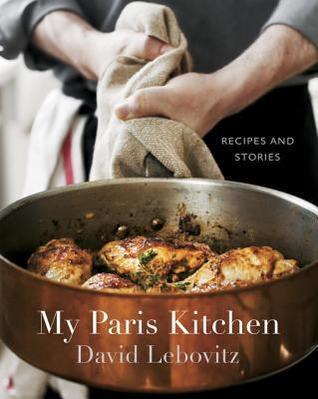


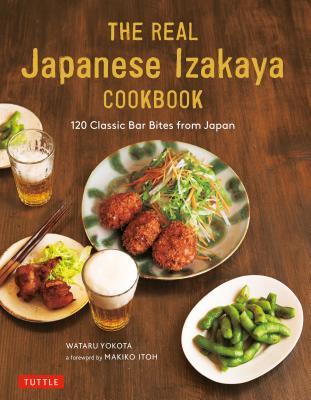
Nonfiction Thursday: Cookbooks from Around the World
My Paris Kitchen by David Lebovitz
It’s been ten years since David Lebovitz packed up his most treasured cookbooks, a well-worn cast-iron skillet, and his laptop and moved to Paris. In that time, the culinary culture of France has shifted as a new generation of chefs and home cooks—most notably in Paris—incorporates ingredients and techniques from around the world into traditional French dishes.
In My Paris Kitchen, David remasters the classics, introduces lesser-known fare, and presents 100 sweet and savory recipes that reflect the way modern Parisians eat today. You’ll find Soupe à l’oignon, Cassoulet, Coq au vin, and Croque-monsieur, as well as Smoky barbecue-style pork, Lamb shank tagine, Dukkah-roasted cauliflower, Salt cod fritters with tartar sauce, and Wheat berry salad with radicchio, root vegetables, and pomegranate. And of course, there’s dessert: Warm chocolate cake with salted butter caramel sauce, Duck fat cookies, Bay leaf poundcake with orange glaze, French cheesecake...and the list goes on. David also shares stories told with his trademark wit and humor, and lush photography taken on location around Paris and in David’s kitchen reveals the quirks, trials, beauty, and joys of life in the culinary capital of the world.
Jerusalem by Yotam Ottolenghi
In Jerusalem, Yotam Ottolenghi and Sami Tamimi explore the vibrant cuisine of their home city—with its diverse Muslim, Jewish, and Christian communities. Both men were born in Jerusalem in the same year—Tamimi on the Arab east side and Ottolenghi in the Jewish west. This stunning cookbook offers 120 recipes from their unique cross-cultural perspective, from inventive vegetable dishes to sweet, rich desserts. With five bustling restaurants in London and two stellar cookbooks, Ottolenghi is one of the most respected chefs in the world; in Jerusalem, he and Tamimi have collaborated to produce their most personal cookbook yet.
Persiana by Sabrina Gahyour
A celebration of the food and flavours from the regions near the Southern and Eastern shores of the Mediterranean Sea, with over 100 recipes for modern and accessible Middle Eastern dishes, including Lamb & Sour Cherry Meatballs; Chicken, Preserved Lemon & Olive Tagine; Blood Orange & Radicchio Salad; Persian Flatbread; and Spiced Carrot, Pistachio & Coconut Cake with Rosewater Cream.
The Real Japanese Izakaya Cookbook by Wataru Yokota
Izakaya cooking is all about enjoying hearty and flavorful Japanese food with drinks and friends at your local hole-in-the-wall hangout. Similar to tapas or pub food, izakaya fare ranges from tasty bar snacks to substantial salads, stews, grilled meats and seafood dishes--all made fresh with minimal fuss and maximum flavor--and served alongside a chilled glass of beer or sake.
The Real Japanese Izakaya Cookbook allows you to recreate over 120 of these classic izakaya dishes in your own kitchen at home. These include standards like Yakitori Chicken Skewers, Crispy Gyoza, and Grilled Wagyu Beef with Shiso. Vegans and vegetarians are also well catered to with dishes like Daikon Salad with Yuzu Dressing, Chargrilled Fava Beans and Baked Tofu with Ginger Sauce. Chef and author Wataru Yokota adds his own unique twists to signature Japanese recipes, like Miso-Simmered Pork and Grilled Mackerel with Plum Sauce.
#cookbooks#cooking#food#nonfiction#Nonfiction Reading#nonfiction reads#Library Books#Book Recommendations#book recs#Reading Recs#reading recommendations#TBR pile#tbr#tbrpile#Want To Read#to read#Booklr#book tumblr#book blog#library blog
4 notes
·
View notes
Text
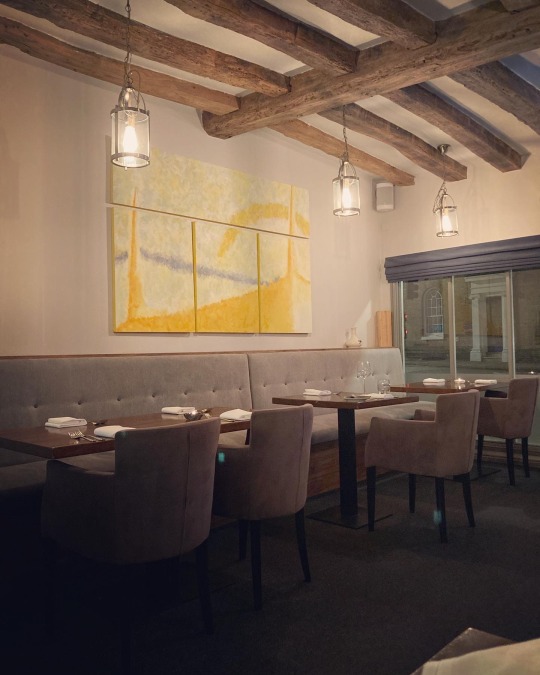

13 May: birthday dinner at 1921 Angel Hill, Bury St Edmunds
this was a special dining experience, as Loverboy took me to a Michelin-starred restaurant for my birthday dinner. it was of course exquisite, and still a very comfortable atmosphere. I tried frogs legs, foie gras, and duck, liked everything except the texture of foie gras, and also enjoyed two delightfully strong cocktails.
more thoughts on each course below, but for now 11/10, definitely recommend, and ideally will make our special spot for future celebratory dinners.

we chose to do the 5 course tasting menu, which began with an assortment of canapés, which are extra-fancy hors d'oeuvres. the selection included smoked tuna on an anchovy cracker, tikka frog leg, mushroom croquette & quail's egg, something with beef tartare, something in caviar, and other things I forget what they were but they were delicious little morsels.
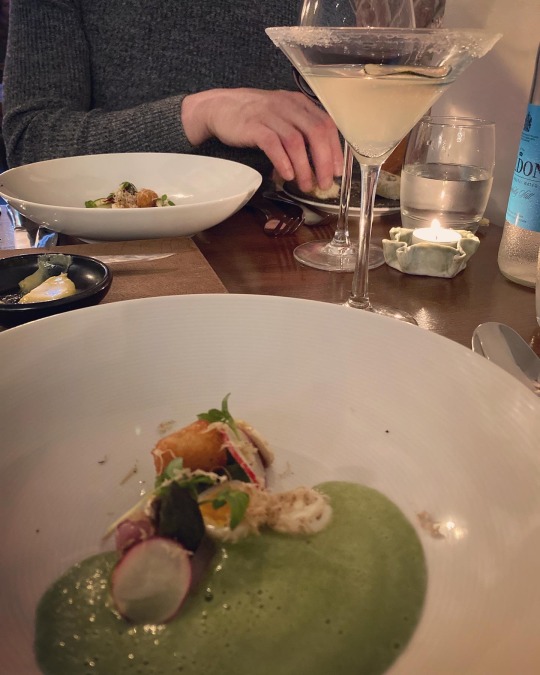
1st course: asparagus soup
this was so delectable it made me tear up a little bit. genuinely. I love asparagus to begin with but this "velouté" was next level. the truffels and quail egg were served in the bowl, and then the creamy velouté was poured at the table. I could have licked the bowl clean if it wouldn't have embarrassed my husband.
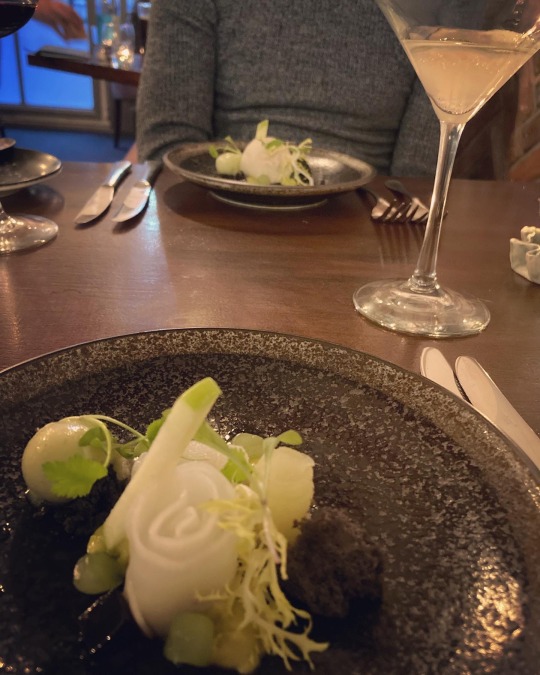
2nd course: wasabi mooli salad
the restaurant was able to accommodate my shellfish allergy, and made this dish without the mersea crab for me. the substitute was simply more pickled mooli (white radish), which was very good but had a very strong flavour on its own. I know I am not one to critique a Michelin star restaurant, but I do wish that they had actually substituted another more mellow-flavoured element in place of the crab. something like grilled chicken or even tofu, but... what do I know! all that to say, this was good but it was the only dish I did not finish as the pickled flavour of the mooli was just too strong to be enjoyed on its own for me.

3rd course: surf n turf but make it fancy ;)
this was another originally-shellfish dish, but they substituted the scallops for seared sea bass on my plate. chicken wings and chicken gravy complimented the fish unexpectedly well, and I could have eaten a whole basket of the morels alone to be honest. If I could order a full dinner sized plate from the tasting menu selection, it would be this dish.

4th course: duck and white bean cassoulet
the seared duck breast was served with rhubarb, and while I loved the duck I was not a fan of the rhubarb. i ate some of it but not all. I also cut the duck meat away from the strip of fat, which my partner said was meant to be eaten together. I cannot stand the texture of animal fat, so I may have committed a faux pas by cutting it off but I wanted to enjoy the duck meat in the way I knew I would.
the little sauce pan served as a side dish contained a white bean cassoulet (beans and shredded beef, but fancy), and foie gras. I imagine the foie gras was imported or produced ethically, as foie gras production is illegal in the UK. I loved the bean and beef cassoulet, but the texture of the foie gras was not very palatable to me.
in order to not make it sound like I didn't enjoy this course, because I very much did, I want to state in no uncertain terms that the duck was i n c r e d i b l e and also I want the white bean cassoulet served with everything else I eat from now on. just without foie gras ;)

5th course: dessert!
the pastry crumbles, the sorbet, the yuzu curd, the pudding-esque caramel-y strip of delicious goop winding beneath it all was *literally chef's kiss* I could kiss the chef for this. my massive sweet tooth wished for more but my rational, polite side knew it was the perfect little bite of sweetness after the savory dishes that preceded it.
again, 11/10 dining experience. I do not know exactly how Michelin stars are earned and maintained, but I dare say this restaurant is certainly deserving. and I want more asparagus velouté soup.
#american in england#get in my belly#fine dining#michelin star#1921 angel hill#angel hill#bury st edmunds#foie gras#veloute#cassoulet#michelin guide#canapes#hors d'oeuvres#mooli raddish#foodie
4 notes
·
View notes
Text


French Onion Soup | Lori Levin
French onion soup is traditionally topped with Gruyère, but other cheeses can be used. Most French onion soups are topped with three cheeses for maximum decadence.
½ cup unsalted butter
2 tablespoons olive oil
4 cups sliced onions
5 cups beef broth
2 tablespoons dry sherry
1 teaspoon dried thyme
1 pinch salt and pepper to taste
4 slices French bread
4 slices provolone cheese
2 slices Swiss cheese, diced
¼ cup grated Parmesan cheese
Directions
Melt butter with olive oil in an 8-quart stock pot over medium heat. Add onions to butter and continually stir until tender and translucent. Do not brown the onions.
Add beef broth, sherry, and thyme. Season with salt and pepper. Let simmer for 30 minutes. Meanwhile, preheat the oven's broiler.
Ladle soup into oven-safe serving bowls and place one slice of bread on top of each (bread may be broken into pieces if you prefer). Layer each slice of bread with a slice of provolone, 1/2 slice diced Swiss and 1 tablespoon Parmesan cheese.
Place bowls on a cookie sheet and broil in the preheated oven until cheese bubbles and browns slightly, 2 to 3 minutes.
What can in use instead of Sherry? lol any red wine :D



French cuisine is known for its rich flavors and variety of dishes, including stews, soups, and baked goods.
Coq au vin: A stew of chicken or rooster braised in wine, mushrooms, onions, and seasonings. It's often served with potatoes or bread.
Boeuf bourguignon: A stew made with beef, vegetables, and red wine from the Burgundy region. [improv making this, no onions]
Cassoulet: A bean casserole that originated in southern France and is typically made with pork or duck.
Pot-au-feu: A stew made with beef, vegetables, and herbs.
Bouillabaisse: A fish soup that originated in Marseille and is traditionally made with European conger, red rascasse, or sea robin.
French onion soup: A classic French soup.
Making a highbred French No-Onion Soup, that resembles Boeuf Bourguignon bc there is a tonne of vegetables + beef. It has cheese, three to be exact bc I was gunning for decadence...bc I was winging it in terms of the sequence of throwing in the ingredients. Well I guess this is why we're supposed to amass every ingredient before starting, in case we actually are missing a common staple that should actually be in the pantry. It smells good, even before I add the wine.
So it tastes amazing, no ifs or buts, I do not apologize for the home grown chilis that are making your eyes tear up, you're welcome I just kick started your metabolism & salivation so you can taste your food better & fight off whatever is floating around in the dead air tonight.
Okay maybe next time I will pre-taste the chili to sense whether it's a burner or not, but I wasn't really thinking at all today. You can't go wrong with French Cooking when they use all these flavour cheats like butter/cheese/wine. I threw in chicken stock as a nod to the master chefs who like to confuse their patrons with complexity; it was a total fusion bc I added ginger & a three whole things of garlic.
That was my improv to the lack of onion, I was going to make garlic soup instead as part of my stubborn streak's homage to FOS. And I made it all in one pot, a pressure cooker which I've noticed makes whatever soup look like a consommé despite not skimming off the scum, it's such a great way to make something appealing with minimal effort. All the scum is plastered against the pot, lol it's probably another miracle from GOD tbh bc if you can't replicate it & think I'm lying - I'm absolutely not. HE does this kind of thing from time to time, like I have a dead insect on my room wall from last year which I cursed & it died on the spot. I thought it took a nap or something, but no it bit the spoon. I left it there as a reminder of the power of our words, but tonight is the collapse, so excuse me.
Consommé is defined quite simply as a clear soup made with concentrated stock, but the French word comes loaded with perceived meaning. Consommé comes from the latin consummate, which means ``to complete, finish, or perfect.'' As if to say that any soup besides consommé is rather imperfect.
Yes I ignored every last word of advice from Carl Jung to analyze why so-and-so annoys me, I am not going there tonight, but on the other hand it connects the idea of why treating others badly is hurting yourself. Kind of, if you hate someone bc it is a trait you hate in yourself.. whatever, it's completely fine to be self-loathing.
P.S. I'm joking most things I make can fail big time, this is GOD.





I can see why chefs deconstruct dishes to make for more eye appeal. Some of these dishes look exactly alike. My goal is to find a blogger from Portugal, which has some of the most amazing flavour combinations.
Visual display was prized. Brilliant colors were obtained by the addition of, for example, juices from spinach and the green part of leeks. Yellow came from saffron or egg yolk, while red came from sunflower, and purple came from Crozophora tinctoria or Heliotropium europaeum. Gold and silver leaf were placed on food surfaces and brushed with egg whites. Elaborate and showy dishes were the result, such as tourte parmerienne which was a pastry dish made to look like a castle with chicken-drumstick turrets coated with gold leaf. One of the grandest showpieces of the time was a roast swan or peacock sewn back into its skin with feathers intact, the feet and beak being gilded. Since both birds are stringy, and taste unpleasant, the skin and feathers could be kept & filled with the cooked, minced & seasoned flesh of tastier birds, like goose or chicken.
The most well-known French chef of the Middle Ages was Guillaume Tirel, also known as Taillevent. Taillevent worked in numerous royal kitchens during the 14th century. His first position was as a kitchen boy in 1326. He was chef to Philip VI, then the Dauphin who was son of John II. The Dauphin became King Charles V of France in 1364, with Taillevent as his chief cook. His career spanned sixty-six years, and upon his death, he was buried in grand style between his two wives. His tombstone represents him in armor, holding a shield with three cooking pots, marmites, on it.






This was all preceded by the post by Dr. Steven Gundry on Butyrate & I felt that it worked the moment I jacked my vegg proportion to 75% of the food I eat, not just 33.3% so tonight's meal was in light of this discussion. OMAD + no sugar & minimal fruit intake..? One year from now I'll be different, GOD willing of course. But the dark cloud is still there, something is going to get a lot worse.
youtube
0 notes
Text
I can’t let you guys continue this conversation without pointing out that they’re different meals with different recipes. Boston baked beans (USA) have a molasses/brown sugar/bacon/onion profile and when properly prepared are closer to a thick cassoulet - not so much a soup-type dish as a sort of solid preparation that you can pretty much shape into a mound, like in the thumbnail of that video. They’re thick, sticky and dark brown.
UK beans, as in beans-on-toast, are in a loose tomato sauce. They do not mound; they spread. The tomato sauce is rather like a more sophisticated spaghettiO sauce in texture, and in taste is pleasant but with a strong tomato profile, much like ketchup.
Sure they have shared roots but this is like starting off your post by saying “ketchup is the same thing as barbecue sauce.” Well, yes, if you zoom out enough, sure! But also, on the more conventional plane, no.
Yes, UK haricot beans in tomato sauce are adapted entirely from indigenous American plant engineering (haricot beans and tomatoes.) no, they did not invent the concept.
No, most Americans will not recognise what is being served when handed a portion of Branston’s. Yes, British people are startled and excited when I produce actual baked beans, which they perceive to be more aligned with a sort of chilli con carne. They are deeply related dishes that exist in conversation with each other and are both influenced by colonialism, but as a dish you might serve someone, they are pretty different in texture, taste, colour, intention, ingredients, and all the sort of things that we look for when describing a food.
Anyway here’s a recipe for my evil UK fusion gluten free huevos rancheros, which will be violently disclaimed as an abomination by every culture involved in the violence of its creation :
Have on hand:
- leftover cooked chicken or pork, chopped or shredded by hand. I usually do this with leftover roast chicken carcass.
- tin of branston beans. I strongly dislike Heinz for not letting you stack the tins. Fuck them.
- enough Sweet Baby Ray’s BBQ sauce (gluten free, available at Tesco/asda/Sainsbury’s in the world food section)
- a lot of whatever fajita seasoning you use to taste
-old El Paso GF tortilla wraps found in the GF section. You can do this with the gluten version, but it will do you good to have to have a recipe written the other way ‘round.
-eggs
-avocado
-shredded cheese
-sour cream, or use up crème fraiche or Greek yogurt if that’s what you have left
-pesto or basil leaves lmao
Shred meat and mix with beans. Heat the meat within the beans with the spices and bbq sauce.
Fry the tortillas on both sides until Activated. (Pronounce them tor-TEE-ya, not turtle-a, thanks). Set aside. You may rub with pesto.
Use that pan to fry eggs UK style. Runny yolks but cooked on top.
Order of assembly: tortilla, beans, fried egg on top. Decorate egg with cheese, sour cream, chopped avocado. Sprinkle basil leaves or coriander if people like coriander.
Surprisingly successful with children, high protein, gluten free, cheap and easy, uses up leftover meat and stuff you probably have around, not too difficult, will cause people on the internet to shout at you. You’re welcome.
Baked beans are an American dish adapted from a similar dish first made by native Americans and baked beans were first canned in the US and then brought to Britain where the British decided to start putting them on toast and calling them a British food. And I’ve started to realize that some British people think that we think beans on toast is strange because we don’t have baked beans. When in fact we’ve had baked beans this whole time. We brought the baked beans over there. We just think it’s mildly confusing that Brits put them on toast.
#you can literally just ask me. “hey who do we know from New England who lives in the UK#you can ask yourself.#before going OH THE UK OR AMERICA DO THIS OR THAT BUT REALLY MEANING THE OTHER THING.#-and I can tell you.#baked beans mean something different and fried eggs are cooked differently.#lucky charms and Reese’s puffs used to be imported at HIGH cost by Sainsbury’s but now they do their own generic versions!#sweet baby ray’s isn’t the best bbq sauce but it’s one of the few GF ones.#British people pronounce tortilla like turtle-a#BUT they have the slight excuse here that Americans won’t understand well#that British people are more familiar with the SPANISH tortilla which is a Spanish dish consisting of egg and potato#much like a quiche#and they’re not expected to pronounce that one properly#much like Americans aren’t expected to say croissant with a French accent#so British people very much struggle with tortilla wrap and chip given their relationship to the quiche one.#you can just ask. I have made it an object of intense study.
15K notes
·
View notes